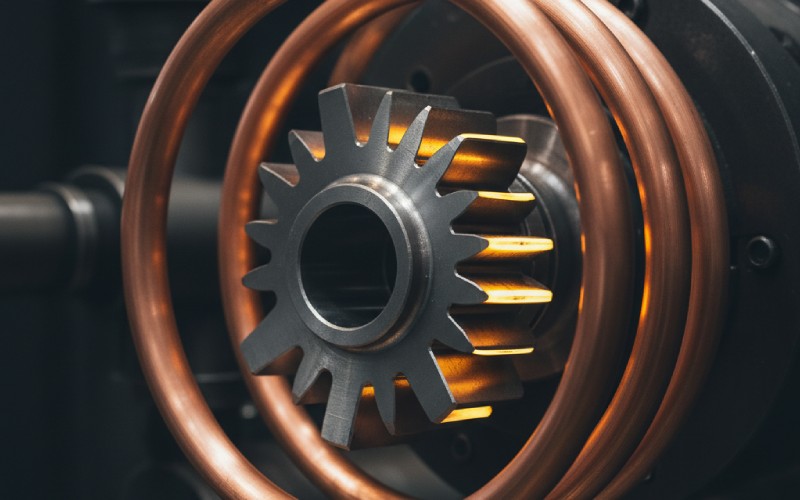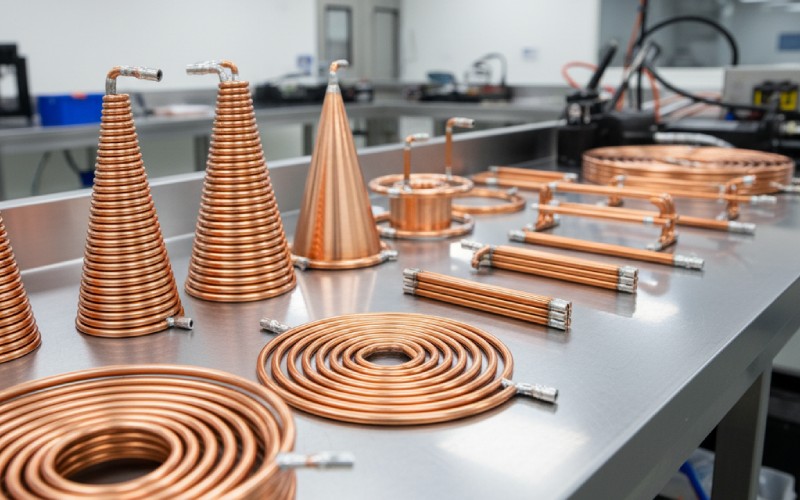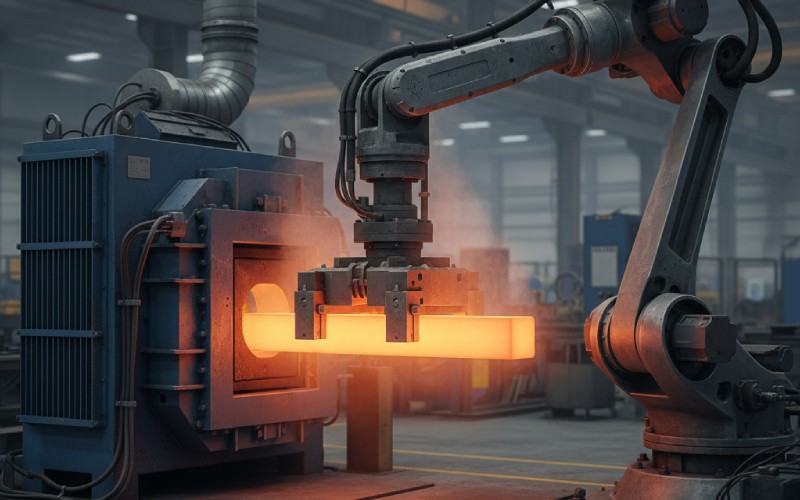Lassen Sie Sino's Lamination Stacks Ihr Projekt verstärken!
Um Ihr Projekt zu beschleunigen, können Sie Lamination Stacks mit Details wie Toleranz, Material, Oberflächengüte, ob eine oxidierte Isolierung erforderlich ist oder nicht, Mengeund mehr.

Haben Sie sich schon einmal gefragt, wie ein Stück Metall in nur wenigen Sekunden ohne Feuer rotglühend werden kann? Das ist kein Trick, das ist Wissenschaft. Der Name dafür ist Induktionswärme. Diese Art der Erwärmung ist schnell, sauber und sehr stark. Viele Fabriken und Werkstätten auf der ganzen Welt nutzen sie.
Dieser Artikel zeigt Ihnen genau, wie ein Induktionsheizgerät funktioniert. Wir werden einfache Worte und gute Beispiele verwenden. Sie erfahren die ersten Dinge, die Sie über diese großartige Technologie wissen müssen. Sie werden auch herausfinden, warum sie in der Regel eine bessere Wahl ist als altmodische Heizmethoden. Wenn Sie die Lektüre beendet haben, werden Sie ein sehr wichtiges Heizwerkzeug verstehen, das heute in Unternehmen eingesetzt wird.
Die Grundlagen der Induktionserwärmung sind leicht zu erlernen. Die Induktionserwärmung ist ein Verfahren, mit dem etwas erhitzt wird, das Strom übertragen kann. In der Regel handelt es sich dabei um ein Stück Metall. Es handelt sich dabei um eine berührungslose Erwärmung. Das bedeutet, dass kein Feuer oder heißer Gegenstand das zu erwärmende Teil berührt. Stattdessen wird eine besondere Art von Energie verwendet, um Wärme aus dem Inneren des Objekts zu erzeugen.
Stellen Sie sich eine spezielle Spule vor, die aus einem Kupferrohr gefertigt ist. Durch diese Spule fließt ein elektrischer Strom. Dadurch bildet sich rund um die Spule ein Magnetfeld. Wenn Sie ein Stück Metall in dieses Feld halten, geschieht etwas Erstaunliches. Das Feld bewirkt, dass sich sehr kleine elektrische Ströme im Inneren des Metalls in Kreisen bewegen. Diese Ströme verursachen Reibung und Wärme. Das ist das Geheimnis, wie Induktionswärme funktioniert. Es handelt sich um eine sehr direkte und energiesparende Methode der Erwärmung.
Die Wissenschaft, die die Induktionswärme ermöglicht, ist keine neue Idee. Die Geschichte der Induktion begann schon vor langer Zeit, in den 1830er Jahren. Ein Wissenschaftler namens Michael Faraday fand etwas Interessantes heraus. Er erkannte, dass ein sich veränderndes Magnetfeld einen elektrischen Strom in einem nahe gelegenen, elektrisch leitenden Material induzieren kann. Dies ist der Grundgedanke, nach dem viele Dinge funktionieren, von Elektromotoren bis zu den Maschinen, die Induktionswärme erzeugen.
Lange Zeit war dies nur eine interessante Tatsache für Wissenschaftler. Aber in den frühen 1900er Jahren fanden Ingenieure heraus, wie man diesen Prozess viel stärker machen kann. Sie bauten die allerersten Induktionserwärmungsanlagen. Fabriken nutzten sie zur Herstellung von Teilen für Panzer und Flugzeuge während der Kriege. Seit dieser Zeit hat sich die Technologie der Induktionserwärmung stark verbessert. Heute wird die Induktionserwärmung für viele Arten von Erwärmungsanwendungen eingesetzt.
Der wichtigste Teil eines Induktionsheizers ist die Induktionsspule. Diese Spule hat die größte Aufgabe zu erfüllen. Durch die Spule fließt ein elektrischer Wechselstrom. Dadurch entsteht um die Spule herum ein starkes Magnetfeld, das sich sehr schnell ändert. Dieses spezielle Feld, das magnetische Wechselfeld, ist es, das den Erwärmungsprozess in Gang setzt. Die Spule wird nicht von selbst heiß. Stattdessen sorgt sie dafür, dass das Werkstück, das man in sie hineinlegt, sehr heiß wird.
Wenn Sie ein leitfähiges Material wie Stahl oder Kupfer in die Induktionsspule legen, wirken zwei Dinge zusammen, um Induktionswärme zu erzeugen.

Ein Induktionsheizsystem besteht aus mehr als nur einer Spule. Sie braucht auch etwas, das als Gehirn und Stromquelle dient. Die Netzteile übernehmen diese beiden Aufgaben. Sie nehmen normalen Strom aus einer Steckdose auf. Dann wandeln sie ihn in die spezielle Art von Strom um, die die Induktionsspule benötigt. Induktionsstromversorgungen sind ein wichtiger Bestandteil der Steuerung der Induktionswärme.
Das Netzteil ist vor allem für zwei Dinge zuständig: Frequenz und Leistung. Die Frequenz gibt an, wie schnell der Strom in der Spule die Richtung wechselt. Die Leistung ist die Gesamtenergie, die an die Spule gesendet wird. Unterschiedliche Aufgaben erfordern unterschiedliche Einstellungen. Bei der Hochfrequenz-Induktionserwärmung wird zum Beispiel nur die Außenhaut eines Metallteils erhitzt. Mit einer niedrigeren Frequenz kann die Induktionswärme tiefer in das Teil eindringen. Die Stromversorgung arbeitet mit einem speziellen Teil, dem sogenannten Tankkreislauf. Gemeinsam geben sie die richtige Menge an Heizleistung ab.
Die Spule ist das wichtigste Teil für jede Induktionserwärmung. Sie können die Induktionsspule als das wichtigste Heizwerkzeug betrachten. Die Form und Größe der Spule bestimmt, wohin die Induktionswärme fließt. Sie bestimmt auch, wie gut der Prozess funktioniert. Ein gutes Spulendesign ist das Geheimnis für ein gutes Ergebnis. Wenn die Spule die falsche Form für das Teil hat, geht Energie verloren und das Ergebnis ist nicht gut.
Das Hauptziel besteht darin, dass das von der Spule erzeugte Feld seine Energie bündelt. Es sollte sich genau auf den Bereich des Werkstücks konzentrieren, den Sie erwärmen müssen. Für einen langen, geraden Stab eignet sich eine einfache runde Heizspule am besten. Für ein flaches Teil könnte eine flache "Pfannkuchen"-Spule die bessere Wahl sein. Der Abstand zwischen der Spule und dem Teil ist ebenfalls sehr wichtig. Das Teil erhält mehr Induktionswärme, wenn es näher an der Spule liegt. Die Spule erzeugt einen sehr starken Strom. Aus diesem Grund wird sie normalerweise aus einem hohlen Kupferrohr hergestellt. Dies ermöglicht eine Wasserkühlung, um ein Schmelzen der Spule zu verhindern.
Eine sehr häufige Anwendung der Induktionswärme ist das Induktionshärten. Mit dieser Methode wird die Außenseite eines Metallteils sehr hart und widerstandsfähig gemacht. Teile wie Zahnräder oder Achsen brauchen eine harte Oberfläche, damit sie sich nicht abnutzen. Gleichzeitig soll das Innere des Teils etwas weicher sein, damit es nicht bricht.
Beim Induktionshärten wird eine speziell angefertigte Arbeitsspule verwendet. Sie erwärmt schnell nur die Oberfläche des Teils. Die Induktionswärme wird sehr gezielt eingesetzt. Die Oberfläche wird in nur wenigen Sekunden sehr heiß. Gleich danach wird das Teil mit Wasser oder Öl sehr schnell abgekühlt. Diese schnelle Erwärmung und Abkühlung verändert die Art und Weise, wie das Metall an der Oberfläche aufgebaut ist, und macht es sehr hart. Das Innere des Teils wird nicht heiß und bleibt daher weich. Auf diese Weise erhält man das Beste von beidem: ein zähes Teil mit einer Oberfläche, die lange Zeit hält.
Ja, das Induktionsschmelzen ist eine weitere sehr wichtige Art, die Induktionserwärmungstechnologie zu nutzen. Die gleichen Ideen, die zum Erhitzen eines Metallstücks verwendet werden, können auch zum Schmelzen verwendet werden. Für diese Art von Arbeit wird ein starkes Induktionserwärmungssystem verwendet. Sie verfügt über einen speziellen Topf, der Tiegel genannt wird. Das leitfähige Material wird in den Tiegel gegeben, und der Tiegel wird in die Spule gestellt.
Die starke Induktionswärme lässt die Temperatur des Metalls schnell bis zum Schmelzpunkt ansteigen. Einer der besonderen Vorteile der Induktionserwärmung zum Schmelzen ist die Art und Weise, wie das Magnetfeld das flüssige Metall umrührt. Durch diese Rührwirkung wird das Metall sehr gut vermischt. Dies führt zu einem hochwertigeren und gleichmäßigeren Endprodukt. Ein Induktionsschmelzsystem ist sauber und verbraucht nicht viel Energie. Im Vergleich zu älteren Öfen ist der Wärmeverlust sehr gering.
Wenn Sie die Induktionserwärmung mit älteren Heizmethoden wie Gasöfen oder Flammenerwärmung vergleichen, werden Sie große Unterschiede feststellen. Die Induktionserwärmung hat viele gute Seiten, die sie für viele Aufgaben in der Induktionserwärmungsindustrie zur besseren Wahl machen.
Hier ist ein einfaches Diagramm, das die wichtigsten Unterschiede aufzeigt:
| Merkmal | Induktionserwärmung | Traditionelle Heizung (wie Flamme oder Ofen) |
|---|---|---|
| Geschwindigkeit | Sehr schnell. Es kann Dinge in nur wenigen Sekunden erhitzen. | Langsam. Es kann viele Minuten oder sogar Stunden dauern. |
| Energieeinsatz | Funktioniert sehr gut. Über 80% Energie erwärmt das Teil. | Funktioniert nicht gut. Ein großer Teil des Wärmeverlustes geht an die Luft. |
| Sicherheit | Viel sicherer. Es gibt kein offenes Feuer. Es ist eine flammenlose Heizung. | Kann gefährlich sein. Es besteht die Gefahr von Feuer, Verbrennungen und schlechten Dämpfen. |
| Ziel | Sehr genau. Erhitzt nur den Teil, den Sie erhitzen möchten. | Nicht genau. Es erwärmt das ganze Teil und die Luft drum herum. |
| Sauberkeit | Sehr sauber. Es entsteht kein Rauch, kein Schmutz, kein Abfall. | Kann schmutzig sein. Er erzeugt Rauch und muss gereinigt werden. |
| Kontrolle | Großartig. Es ist einfach, die Hitze und Heizzeit zu kontrollieren. | Nicht gut. Es ist schwer, die Hitze genau zu kontrollieren. |
Sie sehen, die Vorteile der Induktionserwärmung machen sie zur ersten Wahl für die heutige Produktion. Es ist ein intelligenter Weg, Induktionswärme zu nutzen.
Die Leute fragen oft nach der Erwärmungstiefe. Wie weit geht die Induktionserwärmung wirklich ins Innere des Metalls? Dies ist eine sehr wichtige Frage. Sie wird durch die Frequenz des Wechselstroms in der Spule gesteuert. Ingenieure können die Eindringtiefe der Erwärmung sehr genau steuern.
Die Regel ist sehr einfach:
Durch die Wahl der richtigen Frequenz kann ein Induktionssystem so eingestellt werden, dass es ein Teil genau an der Stelle erwärmt, an der es benötigt wird. Dieser Grad der Kontrolle ist einer der größten Vorteile der Induktionserwärmung.

Wir haben über viele gute Dinge über Induktionswärme gesprochen. Lassen Sie uns die wichtigsten Vorteile der Induktionserwärmung in einer Liste zusammenfassen, damit sie leicht zu merken sind. Der Einsatz der Induktionserwärmung bietet viele Vorteile für Werkstätten und Fabriken.